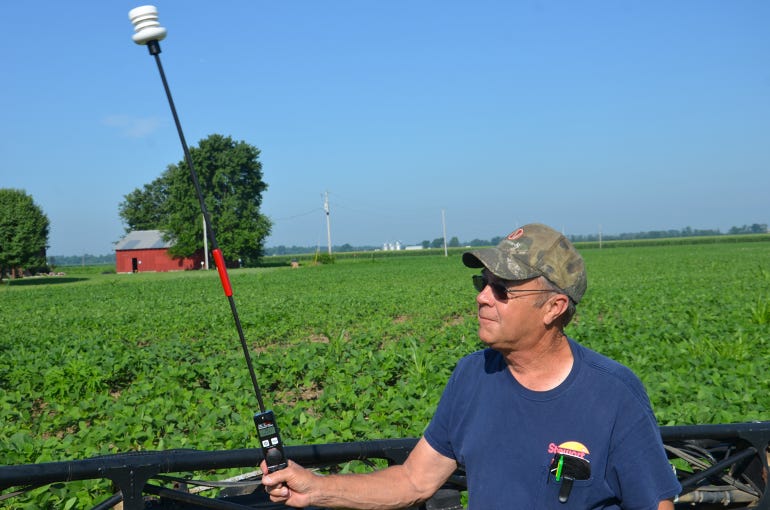
If you spray the newest dicamba herbicides on Xtend soybeans, then “temperature inversion” may already be a household term. Some people believe temperature inversions can lead to potential crop injury with off-target movement of dicamba onto sensitive crops.
Meteorologists say temperature inversions occur when the air several feet above the ground is warmer than the air at ground level. Such inversions are relatively common in Indiana during spraying season, especially in the evening and early morning, says Bill Johnson, a Purdue University weed control specialist.
When the U.S. EPA renewed registration for these herbicides, it added restrictions that prohibit spraying until one hour after sunrise and requires stopping two hours before sunset.
Helpful invention
A colleague knew William Hughes was an inventor. When he realized a better way to detect temperature inversions could help people decide when to spray, he encouraged Hughes to tackle the problem. Hughes built two prototypes and came up with the SpotOn Inversion Tester. His company, Innoquest Inc., Woodstock, Ill., began offering it last spring.
The tool measures air temperature near sprayer boom height, at 1 meter above the ground, and at 3 meters. If the 3-meter reading is higher, it reports an inversion.
Normally, temperature cools as you move up from ground level, Hughes explains. Spray particles can push upward instead of moving sideways. However, when the air at 3 meters is warmer than at 1 meter, particles are trapped. In theory, even a half-mile-an-hour breeze can move particles a half-mile in an hour, Hughes says. That could be onto your neighbor’s field.
Test the device
Innoquest sent me a SpotOn Inversion Tester to try in 2018. Even though I am usually challenged in this area, the instructions are straightforward. The company’s website also features a video of Hughes demonstrating the device.
I tried the tool, and then asked a friend to try it. I visited a farmer and asked him to try it. You simply wave the wand first at 1 meter, let the temperature register, and then wave it above your head at 3 meters until it registers again. It usually takes about a minute each time. If it detects an inversion, it notes it on the digital readout. It also reports temperatures and temperature difference.
Other than the farmer’s son laughing because he thought Dad looked funny, the “tests” went off without a hitch. Later, high school students wanting to learn about technology tried it and did it correctly.

PRODUCT TEST: Jim Facemire, Edinburgh, Ind., put the SpotOn Inversion Tester through its paces when we asked him to try it. There was no temperature inversion present on the morning he was ready to spray.

If the tester detects a 0.3-degree-F increase at 3 meters, it reports an inversion. Some believe it’s not an issue until there’s at least a 1-degree difference.
“We wanted to be conservative,” Hughes says. “Since it displays temperature difference, make up your own mind as to what’s an inversion.”
Dawn Robles, Innoquest sales manager, says the SpotOn Inversion Tester retails at $375. Robles adds that Innoquest recently received an AE50 award for the tester as an outstanding invention in 2018. The award is sponsored by the American Society of Agricultural and Biological Engineers Resource magazine.
About the Author(s)
You May Also Like




